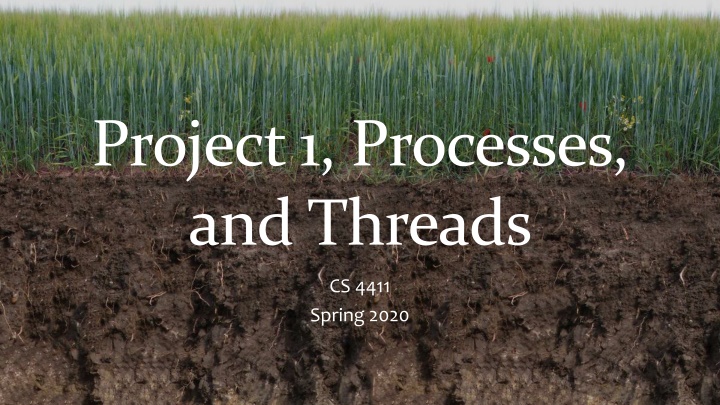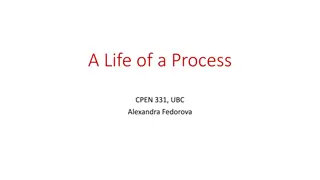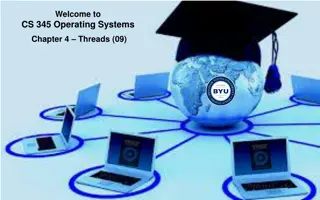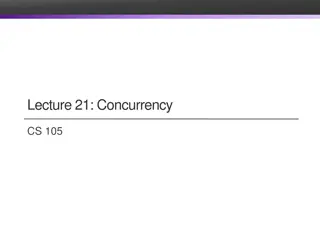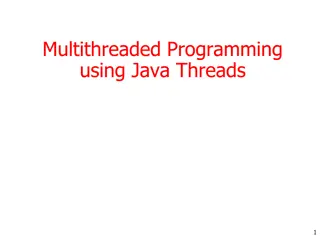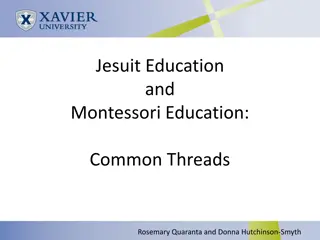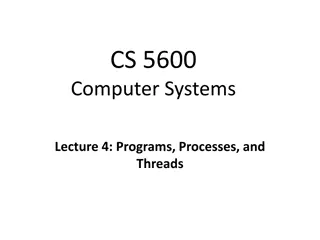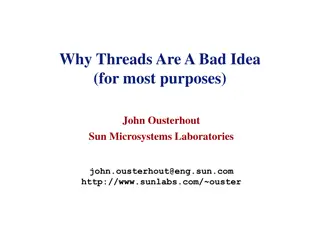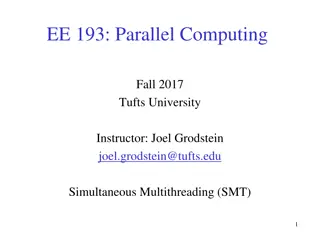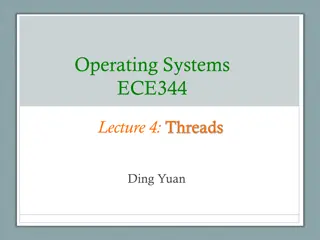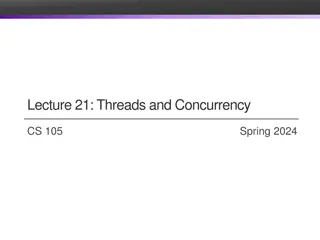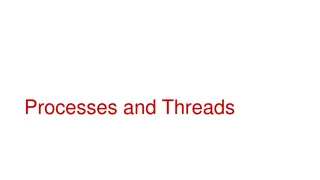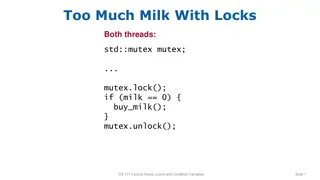Processes and Threads Overview
Dive into the fundamentals of processes and threads in CS 4411 Spring 2020. Explore the differences between processes and threads, context switching, and kernel vs. user-level threads. Get an overview of Project 1 and understand memory layout within a process. Discover how concurrent execution works and the importance of managing multiple tasks within a program effectively.
Download Presentation

Please find below an Image/Link to download the presentation.
The content on the website is provided AS IS for your information and personal use only. It may not be sold, licensed, or shared on other websites without obtaining consent from the author.If you encounter any issues during the download, it is possible that the publisher has removed the file from their server.
You are allowed to download the files provided on this website for personal or commercial use, subject to the condition that they are used lawfully. All files are the property of their respective owners.
The content on the website is provided AS IS for your information and personal use only. It may not be sold, licensed, or shared on other websites without obtaining consent from the author.
E N D
Presentation Transcript
Project 1, Processes, and Threads CS 4411 Spring 2020
Outline for Today Intro to EGOS and GitHub Address Space Layout Processes vs. Threads Context Switching Kernel vs. User-Level Threads Project 1 Overview
EGOS Grass Microkernel OS running on a virtual machine Earth simulates a machine within a single process of your host OS Grass implements an OS kernel running on this VM Block Cache FS Threads Scheduler Earth RAM Disk Host OS (Linux, Mac) NIC RAM Disk CPU Clock Hardware
GitHub Logistics EGOS code will be distributed via a GitHub repository https://github.coecis.cornell.edu/cs4411- 2020sp/egos To access this repository, you will need to join the cs4411-2020sp organization fill out the Google form Suggestion: Fork the EGOS repo and share it with your partner Reminder: All EGOS repos must remain private, not public Question: Would you like a lecture on how to use Git?
Outline for Today Intro to EGOS and GitHub Address Space Layout Processes vs. Threads Context Switching Kernel vs. User-Level Threads Project 1 Overview
Memory Layout 0xFFFFFFFF Two segments of memory: Kernel Space and User Space User processes cannot access Kernel Space memory User processes cannot access any other process s memory Kernel Kernel Space User Space Emacs Mail Shell 0x00000000
Within a Process 0xFFFFFFFF Physical addresses 0xFFFFFFFF Kernel Kernel Kernel space reserved in every process Kernel Space Interrupt stack Stack User Space Emacs Unmapped memory Mail Heap Shell Data Virtual addresses Code 0x00000000 0x00000000
Concurrent Execution What if our program needs to do 2 things at once? Listen for user input, and also spell-check file Do we need 2 entire processes? What is the difference between these 2 processes? 0xFFFFFFFF Kernel Stack Emacs user- input Heap Data Code Emacs spell- check Stack Mail Heap Data Code Shell 0x00000000
Memory Layout with Threads 0xFFFFFFFF 0xFFFFFFFF Interrupt stack Kernel Kernel Kernel Space Thread 1 Stack User Space Thread 1 Registers SP PC Emacs Thread 2 Stack Thread 2 Registers SP PC Mail Heap Shell Data Virtual addresses Code 0x00000000 0x00000000
Outline for Today Intro to EGOS and GitHub Address Space Layout Processes vs. Threads Context Switching Kernel vs. User-Level Threads Project 1 Overview
What is Context? 0xFFFFFFFF To switch from Thread 1 to Thread 2, what needs to be saved? Stack Pointer Program Counter All other CPU registers Interrupt stack Kernel Thread 1 Stack Thread 1 SP PC Thread 2 Stack Thread 2 SP PC Heap Data Code 0x00000000
Where to Save Context? 0xFFFFFFFF Where should Thread 1 s context go? Kernel Thread 1 Stack Thread 1 saved registers Ordinary registers: On Thread 1 s stack SP and PC: In a TCB for Thread 1 Where does TCB go? Depends on type of threads Thread 2 Stack TCB 1 SP PC Status Heap Data Code 0x00000000
Kernel vs. User-level Threads Kernel-level Threads Kernel keeps track of TCBs for threads in all processes Creating and joining require system calls Scheduled by kernel, can be pre-empted pthreads library for C User-level Threads Process keeps track of TCBs for its own threads Scheduled by process that created them No system calls required Cannot be pre-empted user-level process can t pre-empt itself
ULTs and Context Switching When does a user-level thread context switch to another user-level thread? Thread yields explicitly Thread blocks on a synchronization function Thread exits
User-Level Context Switch void ctx_switch(address_t* old_sp, address_t new_sp); ctx_switch: push push push push push push push push push push mov mov pop pop pop pop pop pop pop pop pop pop ret %rbp %rbx %r15 %r14 %r13 %r12 %r11 %r10 %r9 %r8 %rsp, (%rdi) %rsi, %rsp %r8 %r9 %r10 %r11 %r12 %r13 %r14 %r15 %rbx %rbp Save current thread s registers onto its stack Copy current thread s stack pointer to arg 1 Overwrite stack pointer with arg 2 (thread 2 s SP) Pop next thread s registers off its stack Return to next thread at instruction where it called ctx_switch
User-Level Context Switch Why didn t we save or restore the PC? ctx_switch: push push push push push push push push push push mov mov pop pop pop pop pop pop pop pop pop pop ret %rbp %rbx %r15 %r14 %r13 %r12 %r11 %r10 %r9 %r8 %rsp, (%rdi) %rsi, %rsp %r8 %r9 %r10 %r11 %r12 %r13 %r14 %r15 %rbx %rbp Threads only switch by calling this function no pre-emption Function call instructions already save/restore PC
Outline for Today Intro to EGOS and GitHub Address Space Layout Processes vs. Threads Context Switching Kernel vs. User-Level Threads Project 1 Overview
Project 1 Overview Part 1: Implement a user-level threading library Part 2: Implement semaphores for your user-level threads Write test cases for both parts You will need to use the context-switch code provided with EGOS src/h/context.h src/lib/asm_<platform>_<architecture>.s You will also need a queue EGOS provides one just in case Your code will be an application that gets bundled with EGOS when you compile and start it (with make run)
User-Level Threading Interface void thread_init(); Initializes the threading library, allowing us to create threads. void thread_create(void (*f)(void* arg), void* arg, unsigned int stack_size); Creates a new thread that will run function f, a void function with one argument. thread_create s argument arg will be passed to f. void thread_yield(); Causes the current thread to give up the CPU and allow another thread to run. void thread_exit(); Causes the current thread to terminate permanently.
Context Switch Interface void ctx_switch(address_t* old_sp, address_t new_sp); As discussed earlier: Saves current thread s SP in location pointed to by old_sp, then switches to thread whose SP is new_sp void ctx_start(address_t* old_sp, address_t new_sp); Saves current thread s SP in *old_sp, sets SP to new_sp, then jumps to a function named ctx_entry() whose job is to start a new thread You must write ctx_entry() as part of your threading library
Testing Your Code Technically this is a library for EGOS, but since it makes no system calls, you can run it in Linux too Only platform-dependent code is the assembly that implements ctx_switch() and ctx_start() If you copy src/h/context.h and src/lib/asm_*_.s to a new project directory, you can build and run your code as a Linux or Mac executable This makes it easier to debug
